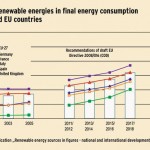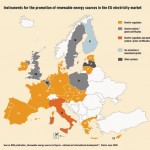The attention of entrepreneurs, investors and the general public is currently focused on the financial crisis and its consequences. Meanwhile, one issue has slipped into the background that, until recently, was at the top of the agenda and has not lost any of its urgency: how will industry, specifically the energy-intensive and resource-dependent chemical industry, cope with the necessary shift of resources? The Achema Special Show will take up this question and show innovative concepts for safeguarding our energy and raw materials supplies.
Dr. Kathrin Rübberdt
Even though, by the end of 2008, the price of oil had reached a low level that no-one would have deemed realistic a few weeks previously, the basic fact that fossil resources are coming to an end is still as valid as ever. The concentration of CO2 in the atmosphere is increasing and climate change can no longer be stopped. Instead, today’s aim is to restrict it to a tolerable +2 degrees. There is still a pressing need for action.
At the same time, the premises of the debate have altered over the last few months – maybe best perceptible in the public’s disillusion regarding biofuels. After a rapid sequence of various renewable resources had been discussed as the ultimate future energy source, euphoria has given way to objective analysis. There is general consensus that, in order to evaluate alternative resources, a holistic summary is necessary: how much energy is required to manufacture a solar cell and how much electricity can it in turn generate over its lifespan? What does a fuel balance boil down to if the transport of rapeseed to the refinery is taken into account? And how many greenhouse gases are released during the production and application of fertilisers for biological resources? None of this is made any easier by the fact that many alternative resources depend on local conditions: in sunny Sicily, a solar cell generates far more electricity over its lifespan than in Norway, resulting in a much better energy balance.
Utilising renewable energy sources
According to the German Federal Ministry for the Environment, Nature Conservation and Nuclear Safety, renewables accounted for 8 % of the EU 27’s energy consumption in 2006. EurObserv’ER lists photovoltaics as the sector with the strongest relative growth rates, while biomass and waste not only enjoy the lion’s share of renewable energy production but also show the largest growth in absolute numbers. This development has been pushed by the EU’s initiative to raise the share of renewables to 20 % by 2020; in 2009, a new guideline with binding targets for each member state will be published. Many European countries have already established support programmes, e. g. Germany with its Renewable Energy Act (EEG) that offers attractive feed-in tariffs to private and commercial suppliers as well as Spain, Greece and Slovenia.
At the same time, considerable sums have been made available to support R&D activities in the field of renewable energy. Thus, Germany in particular has developed into an important centre for research, development and production of photovoltaic technology. The silicon shortage over the last year has likewise contributed to the stepping up of R&D efforts. In addition to thin film cells based on metals and metalloids like gallium, indium, copper, tellurium, arsenic and others which, unfortunately, are also limited resources, scientists are currently focusing on organic solar cells.
Organic materials are, in general, more readily available than the conventional raw materials mentioned above. Significant price reductions can thus be expected in the medium term. What’s more, organic materials offer a whole range of further advantages. Not only can they be optimised systematically (e. g. by designing polymers and using coatings that extend the range of usable solar light), they also open up completely new applications in construction and other areas: flexibility and lightness are just two important catchwords that trigger developers’ fantasies. Yet whereas commercial silicon cells currently have an efficiency of about 14 % and multi-crystalline silicon has surpassed 20 % under laboratory conditions, organic cells so far offer only 4 to 5 % in the lab. However, if we consider the development of organic LEDs, organic solar cells should be competitive as regards the cost per W installed capacity in a couple of years.
By the end of 2007, the installed photovoltaic capacity in the EU amounted to 4700 Mwp, while the global figure for installed solar power was about 9200 MWp. Forecasts for 2010 range between 13,000 and 23,000 Mwp – for new installations alone. Which figure will prove more realistic strongly depends on technological developments and manufacturing costs. This includes all production steps, from the production of pure silicon using encapsulation technology to the costs for installation and for the mechanical drives and control systems necessary for a smooth feed-in to the power grid. For example, the lamination step is currently a bottleneck in the production of photovoltaic modules. Several manufacturers are working on the development of a foil that can be processed faster, or alternatively on double glazing, re- sembling windows, that does not require lamination. Similar technological progress can be expected in several steps of the value chain.
Wind power accounts for about 5 % of primary energy generation in Europe as well as 18 % of electricity at about 81 GWh. Germany is the clear leader, but the potential for further increase is limited: one reason is the public debate on wind power stations “spoiling landscapes”, while the other is even more simple: in many regions there is just not enough wind to make the operation of wind generators economically viable. The focus has therefore moved to large offshore power stations; Sweden, the UK and the Netherlands are the current drivers in this sector. Another problem is the inconstancy of wind energy generation, which fluctuates even more than solar energy. In consequence, the demands on grid planning and control systems are high. To provide for base loads, alternatives to wind energy are imperative.
Sources for energy and materials
A somewhat diffuse distinction line in the current discussion on renewables runs between their use for energy and materials – diffuse because plant material can be assigned to both sides. When used for energy generation, it competes with solar energy, wind energy and others, while when it comes to material usage it is the only alternative to fossil resources.
According to EurObserv’ER, 5.6 Mtoe of energy crops were harvested in Europe in 2006 – an increase of 86.5 % compared to 2005. The share of biofuels in total fuel consumption is still below 2 %. According to the VCI (German Chemical Industry Association), about 6.4 mt of biomass are used as a raw material option for the production of chemicals in Europe. This represents 8 to 10 % of the industry’s total feedstock. Compared to energy generation, material use still plays only a minor role.
There are different ways to use biomass for energy generation: it can be burned directly or converted into liquid fuels or biogas, which can in turn be employed to generate electricity.
A flagship report by the German Advisory Council on Global Change (WBGU) in December 2008 estimates that biomass can contribute 10 % of the world’s energy demand in the medium term. The biggest contribution will come from biomass-to-electricity, especially when used in combined heat and power generation plants. Scientists point out that energy generation should not, however, be promoted at the expense of food production or environmental and climate protection.
This criticism applies especially to first-generation biofuels. In Europe, these are mainly biodiesel and bioethanol produced from crops that are cultivated exclusively for use as energy. During the processing of both fuels, considerable amounts of by-products are generated, and their economic use has to be ensured.
Production of biofuels or biogas
In order to avoid any conflict with food cultivation, many projects rely on residues and waste – for example straw, wood waste and also sludge. Competing processing pathways exist: bio-mass-to-liquid processing leads to synthetic fuels whose composition can be controlled, while unwanted components like aromatic and sulphur compounds can be excluded. The first industrial-scale plant worldwide is currently being built in Freiberg (Germany); it will be operated by Choren Industries. Since, in contrast to first-generation biofuels, not only seed but the entire plant can be used, these fuels achieve much higher efficiencies per area: the German Agency for Renewable Resources (FNR) claims output per ha is about 4000 l of biomass-to-liquid fuels compared to 1550 l of conventional biodiesel.
Fuel plant planning has been aggravated by the current unclear legal situation. Tax and other incentives for the production of biofuels are in the process of being reviewed and, in some cases, have already been reduced on both a European and a national level. This creates problems for the planning and financing of necessary investments in plants.
On the other hand, the generation of biogas from slurry, sludge or silage by means of fermentation has, as a rule, been profitable until recently. In this process, bacteria transform sugar, starch, amino or fatty acids into methane and CO2 in several steps. Methane can then be converted into electricity or – after extensive cleaning – fed into the existing natural gas grid.
One alternative that can convert an even broader range of materials is the chemical gasification of fuels. Several projects based on different gasification technologies are under way. British Gas and Lurgi have developed a dry-ash gasification plant at Schwarze Pumpe (Germany) that requires only 20 % of lignite as basic fuel; the remaining 80 % of organic material can consist of waste, shredded plastics, tars, slag etc. Depending on the fuel composition, the generated syngas consists of about 20 % methane, 14 % hydrogen and 32 % CO with several minor by-products. For this process to work, however, pure oxygen has to be added.
By contrast, plants with a fluidised bed like the biomass power plant in Güssing (Austria) can be operated using air. The hydrogen content of the gas produced there is about 35 to 45 %, while methane accounts for about 10 %. The plant is operated with wood chippings blended with straw and other plant residues. The syngas is used for electricity generation in a combined heat and power generation plant. Alternatively, it can be converted by Fischer-Tropsch synthesis in order to produce liquid fuels; however, this process is currently only being run on an experimental scale. Bio-mass plants based on agricultural residues are operated decentrally in order to minimise transport.
This short overview of renewable resources demonstrates how many technologies are currently being pushed simultaneously – most of them will probably be used commercially in the long term in order to ensure a reasonable energy mix. There is a lot still to be done by scientists, engineers and manufacturers of apparatus: valves, pumps and other equipment have to be tailored to the new raw materials and whole synthetic pathways reviewed and, eventually, redesigned. The dawn of a new era in resources is breaking – process and plant engineering will smooth the way.
Dechema e.V. info@dechema.de www.dechema.de
Achema Special Show

For years, the Achema Special Show has pinpointed emerging sectors of the process industry on the threshold of industrial breakthrough. This year’s Special Show “Chemistry and Biotechnology of Renewable Resources and Energy” addresses the increasing importance of non-fossil resources for the production of energy and materials. In addition to the many facets of industrial (“white”) biotechnology, the Special Show will zero in on biore-fineries, plants for the production of biofuels and biogas, and bioplastics and composites. Photovoltaics, solar-chemical processes and thermal and chemical processes will round off this comprehensive exhibition.
Share:











